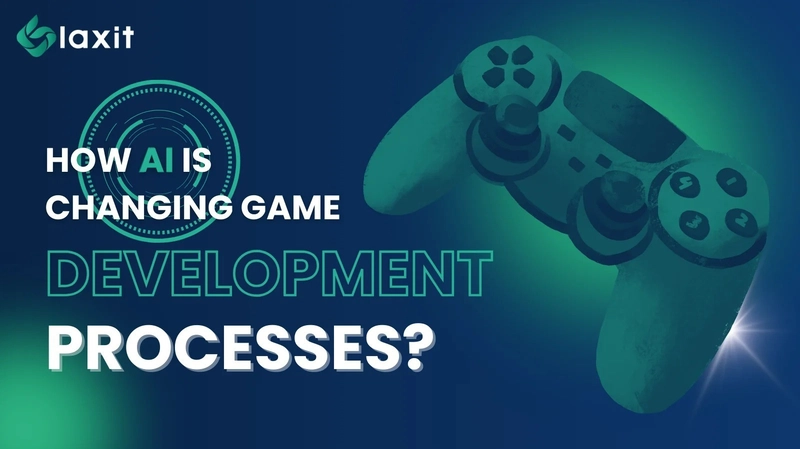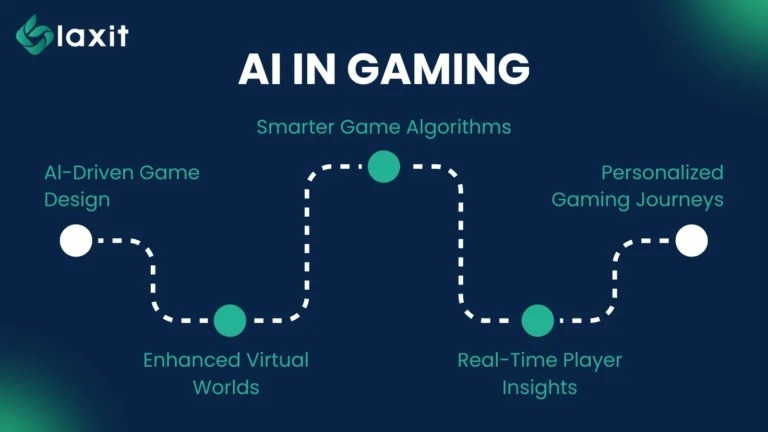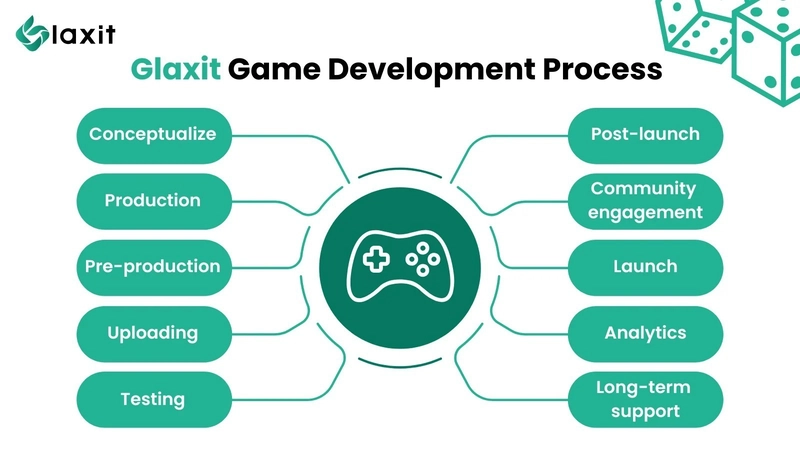How AI is Changing the Game Development Process
Game development has come a long way in the past few decades. In the early days, developers had to write thousands of lines of code manually and create every game element from scratch. Today, Artificial Intelligence (AI) is changing the game quite literally! With AI stepping in, the entire process of game development is becoming faster, smarter, and more efficient. But how is this happening? Let’s break it down in simple terms. What Is AI in Game Development? Artificial Intelligence is the ability of a machine to perform tasks that would normally require human intelligence. This can include decision-making, learning from experience, and problem-solving. In game development, AI can assist, analyze, and even create. It’s like having an extra teammate who never gets tired! For example, if you’ve played games like FIFA, Call of Duty, or The Sims, you’ve already seen AI in action. The opponents you face, the decisions characters make, or how they react to your actions, that’s AI working behind the scenes. AI Helps Speed Up Game Design One of the most significant benefits of AI is that it can help developers build games faster. In the past, it used to take months just to design a single level. But now, AI tools can generate levels in a matter of hours. These tools are trained on existing game data and can learn what players enjoy the most. As a result, they create exciting and engaging game experiences. If a developer were to design each scene manually, it might take too long. But if AI is used, the same process can be completed in much less time. This saves money, energy, and effort. Better Game Characters with AI Creating characters that feel real is not a piece of cake. However, with AI, characters can move, talk, and respond more naturally. AI allows non-playable characters (NPCs) to react based on their actions. For instance, if you scare a character in a game, they might run away or scream. This adds a layer of realism that makes the game more fun and immersive. Let’s say the player enters a village and starts attacking people. If AI is used properly, villagers might fight back, call for help, or flee. Without AI, these characters would just stand there doing nothing and that would ruin the fun! AI Makes Testing Easier Game testing is another area where AI is making waves. Before a game is launched, it must be tested many times to remove bugs. In the past, humans had to play the game again and again to find errors. This was time-consuming and boring. Now, AI bots can do this job quickly. They can play through all levels, detect errors, and report them. If bugs are fixed early, the game becomes smoother and more enjoyable. Moreover, if developers had relied only on manual testing, small bugs might have been missed. But with AI-based testing, games are more stable and perform better. Personalized Gameplay for Everyone Thanks to AI, games can now adapt to each player’s style. This is known as personalized gameplay. If a player is a beginner, the game might become easier. If a player is a pro, the difficulty can increase. AI learns from your behavior and adjusts the game accordingly. For example, if someone always chooses to avoid fights in a game, the AI might offer more stealth missions instead of combat ones. This helps in keeping the game exciting for different types of players. Real-Time Graphics Enhancement AI is also changing how games look. Using machine learning, AI tools can enhance the graphics in real-time. That means players can enjoy high-quality visuals without needing expensive hardware. AI can improve textures, lighting, and even facial expressions in a way that was not possible before. In fact, according to a report by MarketsandMarkets, AI in the gaming market is expected to grow from $1.1 billion in 2021 to $3.6 billion by 2026. This shows how fast the industry is growing. AI and Storytelling Storytelling is the heart of many games. A strong story can make a game unforgettable. With AI, developers can create dynamic stories that change based on player decisions. This is called branching narratives. If a player chooses one path, the story goes in one direction. If they choose another, the story changes. This gives players a sense of control and increases replay value. You may have heard the idiom: “The ball is in your court “. In AI-driven games, that’s exactly how it feels. If we had games without AI-based storytelling, all players would experience the same thing. That could get boring quickly. But if AI is used, every playthrough can feel fresh and new. Challenges of AI in Gaming Of course, nothing is perfect. AI also brings some challenges. It can sometimes make mistakes or act in unexpected ways. Developers must keep an eye on the AI systems and make sure they behave correctly. Also, some fear that AI might replace human creativity. The truth is that AI can assist, but it cannot replace the human touch in s

Game development has come a long way in the past few decades. In the early days, developers had to write thousands of lines of code manually and create every game element from scratch. Today, Artificial Intelligence (AI) is changing the game quite literally! With AI stepping in, the entire process of game development is becoming faster, smarter, and more efficient. But how is this happening? Let’s break it down in simple terms.
What Is AI in Game Development?
Artificial Intelligence is the ability of a machine to perform tasks that would normally require human intelligence. This can include decision-making, learning from experience, and problem-solving. In game development, AI can assist, analyze, and even create. It’s like having an extra teammate who never gets tired!
For example, if you’ve played games like FIFA, Call of Duty, or The Sims, you’ve already seen AI in action. The opponents you face, the decisions characters make, or how they react to your actions, that’s AI working behind the scenes.
AI Helps Speed Up Game Design
One of the most significant benefits of AI is that it can help developers build games faster. In the past, it used to take months just to design a single level. But now, AI tools can generate levels in a matter of hours. These tools are trained on existing game data and can learn what players enjoy the most. As a result, they create exciting and engaging game experiences. If a developer were to design each scene manually, it might take too long. But if AI is used, the same process can be completed in much less time. This saves money, energy, and effort.
Better Game Characters with AI
Creating characters that feel real is not a piece of cake. However, with AI, characters can move, talk, and respond more naturally. AI allows non-playable characters (NPCs) to react based on their actions. For instance, if you scare a character in a game, they might run away or scream. This adds a layer of realism that makes the game more fun and immersive.
Let’s say the player enters a village and starts attacking people. If AI is used properly, villagers might fight back, call for help, or flee. Without AI, these characters would just stand there doing nothing and that would ruin the fun!
AI Makes Testing Easier
Game testing is another area where AI is making waves. Before a game is launched, it must be tested many times to remove bugs. In the past, humans had to play the game again and again to find errors. This was time-consuming and boring. Now, AI bots can do this job quickly. They can play through all levels, detect errors, and report them. If bugs are fixed early, the game becomes smoother and more enjoyable. Moreover, if developers had relied only on manual testing, small bugs might have been missed. But with AI-based testing, games are more stable and perform better.
Personalized Gameplay for Everyone
Thanks to AI, games can now adapt to each player’s style. This is known as personalized gameplay. If a player is a beginner, the game might become easier. If a player is a pro, the difficulty can increase. AI learns from your behavior and adjusts the game accordingly.
For example, if someone always chooses to avoid fights in a game, the AI might offer more stealth missions instead of combat ones. This helps in keeping the game exciting for different types of players.
Real-Time Graphics Enhancement
AI is also changing how games look. Using machine learning, AI tools can enhance the graphics in real-time. That means players can enjoy high-quality visuals without needing expensive hardware. AI can improve textures, lighting, and even facial expressions in a way that was not possible before.
In fact, according to a report by MarketsandMarkets, AI in the gaming market is expected to grow from $1.1 billion in 2021 to $3.6 billion by 2026. This shows how fast the industry is growing.
AI and Storytelling
Storytelling is the heart of many games. A strong story can make a game unforgettable. With AI, developers can create dynamic stories that change based on player decisions. This is called branching narratives. If a player chooses one path, the story goes in one direction. If they choose another, the story changes. This gives players a sense of control and increases replay value. You may have heard the idiom: “The ball is in your court “. In AI-driven games, that’s exactly how it feels. If we had games without AI-based storytelling, all players would experience the same thing. That could get boring quickly. But if AI is used, every playthrough can feel fresh and new.
Challenges of AI in Gaming
Of course, nothing is perfect. AI also brings some challenges. It can sometimes make mistakes or act in unexpected ways. Developers must keep an eye on the AI systems and make sure they behave correctly. Also, some fear that AI might replace human creativity. The truth is that AI can assist, but it cannot replace the human touch in storytelling and design.
Glaxit AI-Powered Game Development Process
At Glaxit, we believe that the future of game development lies in combining human creativity with the power of AI. Our game development process includes AI-driven level design, automated testing, and smart NPC behavior integration. We use machine learning tools to analyze player behavior and continuously improve gameplay experiences.
Our team first gathers client requirements and then designs the game structure with input from AI tools. After that, we develop, test, and optimize the game using AI-based automation. Whether you’re looking to build a mobile game, a PC game, or a VR experience, Glaxit can help turn your ideas into reality faster, smarter, and better.












































































































































































![[The AI Show Episode 142]: ChatGPT’s New Image Generator, Studio Ghibli Craze and Backlash, Gemini 2.5, OpenAI Academy, 4o Updates, Vibe Marketing & xAI Acquires X](https://www.marketingaiinstitute.com/hubfs/ep%20142%20cover.png)



























































































































![[DEALS] The Premium Learn to Code Certification Bundle (97% off) & Other Deals Up To 98% Off – Offers End Soon!](https://www.javacodegeeks.com/wp-content/uploads/2012/12/jcg-logo.jpg)


![From drop-out to software architect with Jason Lengstorf [Podcast #167]](https://cdn.hashnode.com/res/hashnode/image/upload/v1743796461357/f3d19cd7-e6f5-4d7c-8bfc-eb974bc8da68.png?#)









































































































.png?#)

































_Christophe_Coat_Alamy.jpg?#)
 (1).webp?#)




































































































![iPhone 17 Pro Won't Feature Two-Toned Back [Gurman]](https://www.iclarified.com/images/news/96944/96944/96944-640.jpg)
![Tariffs Threaten Apple's $999 iPhone Price Point in the U.S. [Gurman]](https://www.iclarified.com/images/news/96943/96943/96943-640.jpg)







































































































































